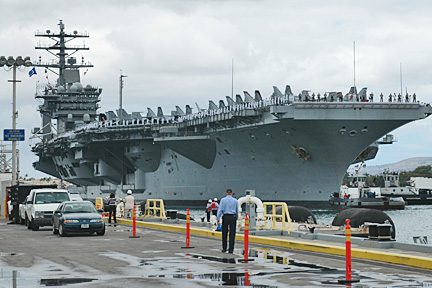Isles court
aircraft carrier
Inouye and Lingle join forces in
a low-key but high-stakes campaign
promising 4,200 jobs
PEARL HARBOR » For Lt. Joe Mitzen there is no question: If the Pentagon decides to base an aircraft carrier in Hawaii, he wants to be on it.
"A lot of guys in my division are very excited about the possibility of living in Hawaii," said the 26-year-old Navy engineer from Nesquehoning, Pa., who serves on the carrier USS Nimitz. "This would just be fantastic -- it's a tropical paradise."
The sailors might get their chance. The Pentagon is considering moving one of its aircraft carriers from the mainland to either Hawaii or Guam to increase the Navy's ability to meet a multitude of potential security threats from North Korea to terrorists in Southeast Asia.
Balancing ActThe Navy is considering either Hawaii or Guam for basing a second aircraft carrier in the Pacific. Military officials see advantages and drawbacks for both islands, which are competing for the jobs and federal spending that would accompany one of the world's biggest ships.
What's at stake
Hawaii pros
Hawaii cons
Source: Associated Press
|
Hawaii leaders, from Republican Gov. Linda Lingle to Democratic Sen. Daniel Inouye, say home-porting a carrier on Oahu would be in both national and state interests.
"For the defense of the country, I think it would be a good move," said Lingle. "Economically, it would add hundreds of millions of dollars to the economy."
The state's campaign to lure one of the world's biggest warships to the islands has been fairly low-key. Inouye has taken the lead, emphasizing to Pentagon officials Hawaii's strategic location, given the rising importance of Asia.
Parts of the community have been studying the idea for a while, including the Chamber of Commerce of Hawaii, which estimated eight years ago that a carrier home-ported in Honolulu would create 4,200 jobs.
The business lobby has not updated its survey since. But in general, the chamber has calculated that every $1 billion in military spending in Hawaii directly and indirectly generates 24,650 local jobs.
The Pentagon already has been sending more troops to the state.
The Army plans to move 800 more soldiers to Oahu early next year for a fast-response, mobile Stryker Brigade. The Air Force will deploy eight C-17 cargo planes here in support of the new unit.
Earlier this month, Hawaii emerged little affected by the Pentagon's Base Closure and Realignment report, even though it recommended shutting down or shrinking dozens of military bases on the mainland.
"I think the BRAC decision should give a hint as to where a carrier would go," said Inouye. "I think policy-makers will decide Hawaii is the place."
It is difficult to overstate the importance of the aircraft carriers, which give the military the ability to rapidly deploy about 80 fighter jets to war almost anywhere in the world.
The Navy now bases 11 of its aircraft carriers on the mainland: five in Norfolk, Va.; three in Washington state; two in San Diego; and one in Mayport, Fla. Another is home-ported in Japan.
In May, some of the ships were headed to and from the Persian Gulf to support U.S. coalition forces in Iraq, while others were moored at port or training at sea.
Guam argues it is better suited to host a carrier because the U.S. territory is 3,700 miles closer to potential hot spots in Asia than Hawaii.

The USS Nimitz docks near the USS Arizona Memorial, right, in Pearl Harbor. The Pentagon is considering whether to base a similar aircraft carrier in either Hawaii or Guam to enable a quick response to potential crises in Asia.
Hawaii also boasts the Pearl Harbor Naval Shipyard, the largest ship repair shop between the West Coast and Asia.
Inouye said Hawaii's extensive highways, including three freeways linking major bases, and Honolulu's Tripler Army Medical Center give the state added advantages over Guam.
Of course, bringing such a large number of people to Oahu, the home of Pearl Harbor, would not be without complications.
Real estate has been selling for record prices in the past year, with the median price of a home on Oahu hitting $550,000 in March. Rush hour traffic jams are a constant headache.
The military would also have to conduct an environmental impact study before it could decide where to move a ship. Residents near bases might complain about noise from the new fighter jets.
Lingle said she would work closely with Hawaii's congressional delegation to ensure the state wins the funds it would need for any school, road, water or sewage system upgrades in support of a carrier deployment.
"Like any opportunity for economic development, there are always going to be impacts," Lingle said. "For the long term, the trade-off is a good one, as long as we get the resources we need to mitigate some of those impacts."
Retired Adm. R.J. "Zap" Zlatoper, commander of the Pacific Fleet from 1994 to 1996 and currently a Honolulu businessman, said strong local support for military families is another factor making Hawaii a great place to base a carrier.
"The decision should be made based on national security and fiscal constraints," Zlatoper said. "But if they decide to base a carrier here, the community is ready."

www.pacom.mil
State of Hawaii
www.hawaii.gov/portal
Naval Station Pearl Harbor
www.pearlharbor.navy.mil
E-mail to City Desk
[News] [Business] [Features] [Sports] [Editorial] [Do It Electric!]
[Classified Ads] [Search] [Subscribe] [Info] [Letter to Editor]
[Feedback]
